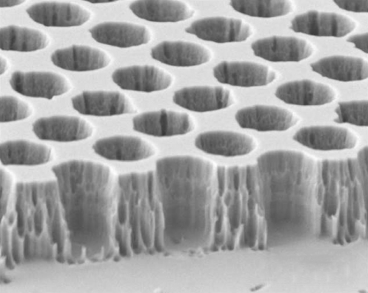Turning heat into power
By By David L Chandler, MIT News Office | 07 Feb 2012
A new kind of high-temperature photonic crystal could someday power everything from smartphones to spacecraft.
 |
| A microscope image of the tungsten photonic crystal structure reveals the precise uniform spacing of cavities formed in the material, which are tuned to specific wavelengths of light. Image courtesy of Y.X. Yeng et al. |
A team of MIT researchers has developed a way of making a high-temperature version of a kind of materials called photonic crystals, using metals such as tungsten or tantalum.
The new materials - which can operate at temperatures up to 1200 degrees Celsius - could find a wide variety of applications powering portable electronic devices, spacecraft to probe deep space, and new infrared light emitters that could be used as chemical detectors and sensors.
Compared to earlier attempts to make high-temperature photonic crystals, the new approach is ''higher performance, simpler, robust and amenable to inexpensive large-scale production,'' says Ivan Celanovic ScD '06, senior author of a paper describing the work in the Proceedings of the National Academy of Sciences. The paper was co-authored by MIT professors John Joannopoulos and Marin Soljacic, graduate students Yi Xiang Yeng and Walker Chen, affiliate Michael Ghebrebrhan and former postdoc Peter Bermel.
These new high-temperature, two-dimensional photonic crystals can be fabricated almost entirely using standard microfabrication techniques and existing equipment for manufacturing computer chips, says Celanovic, a research engineer at MIT's Institute for Soldier Nanotechnologies.
While there are natural photonic crystals - such as opals, whose iridescent colours result from a layered structure with a scale comparable to wavelengths of visible light - the current work involved a nanoengineered material tailored for the infrared range. All photonic crystals have a lattice of one kind of material interspersed with open spaces or a complementary material, so that they selectively allow certain wavelengths of light to pass through while others are absorbed. When used as emitters, they can selectively radiate certain wavelengths while strongly suppressing others.













.jpg)






.jpg)









